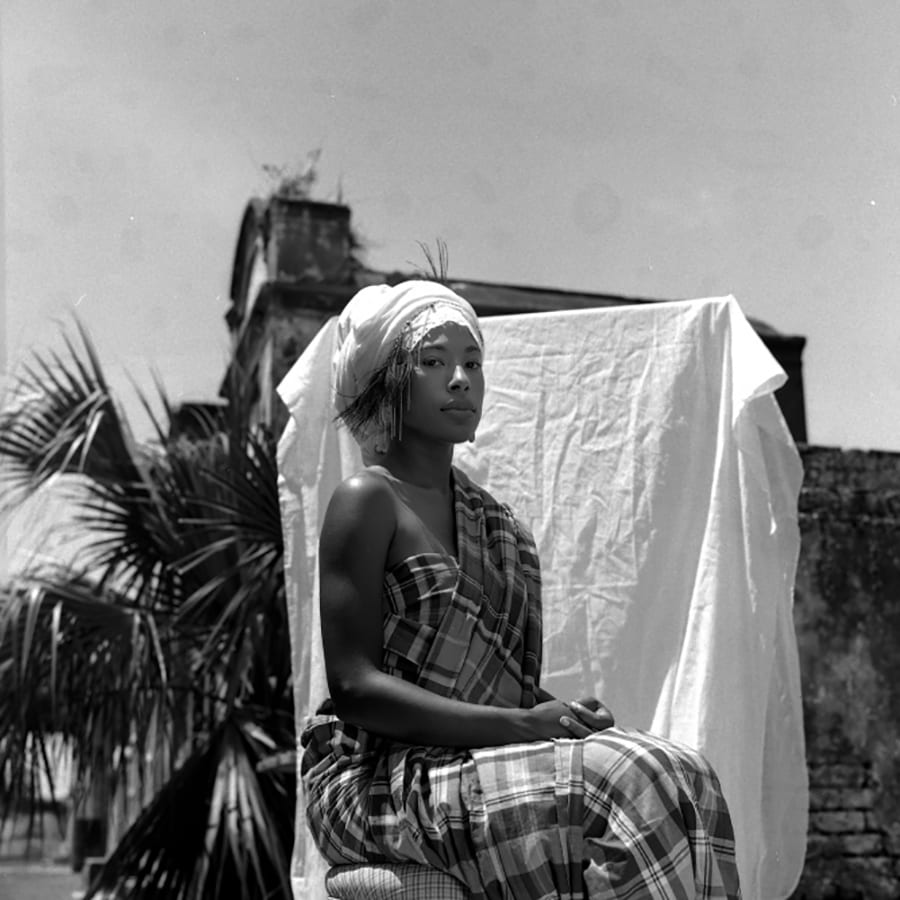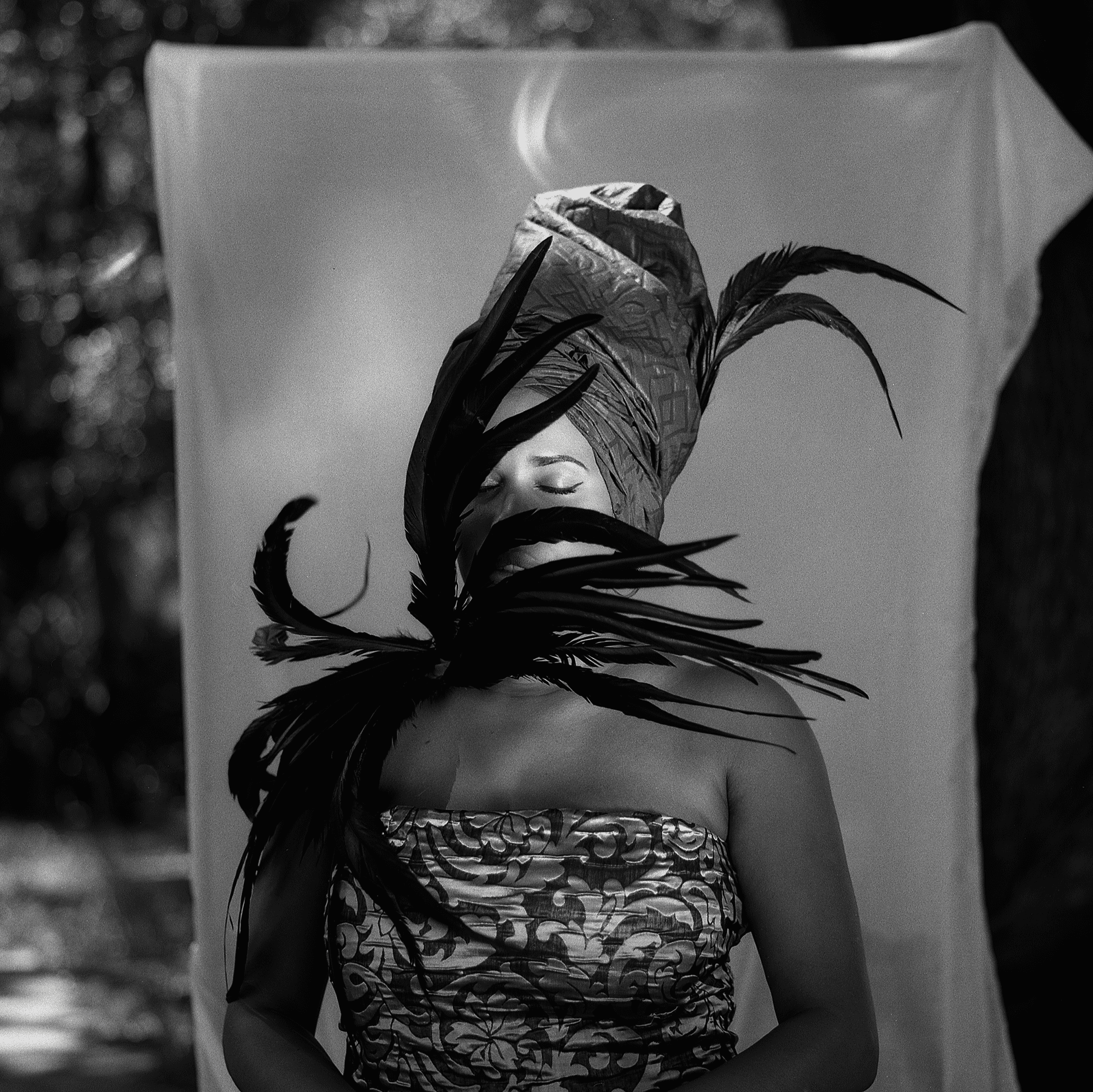This interview is a continuation of a recent conversation between myself and Juliana Kasumu conducted in 2016, prior to the release of From Moussor To Tignon (FMTT). The original interview, which can be found in the Houston Center for Photography library, touched on her creative process while producing the collection, expectations for the body of work, and future directions. In this interview, we explore Kasumu’s positionality within both the arts and her personal community, and how the FMTT series highlights a critical era for black womanhood.
Obafemi Ogunleye (OO): Can you briefly describe how the FMTT project originated and the process of bringing it to life?
Juliana Kasumu (JK): I became passionate about documenting hair practices by Black women after going on my own natural hair journey. I was able to learn so much about myself, particularly in regards to my ancestry. Ultimately, however, I was deeply frustrated when I came to the realization that there was a lack of research and accurate historical records on West African hair methods, its symbolism, and its origins.
While conducting research on one of my earlier projects Irun Kiko, I was led to an edict, put forth by the governor Esteban Rodríguez Miró, a Spanish army officer and governor of the Spanish American provinces of Louisiana and Florida, who mandated Black women, both free and enslaved, to wear headwraps while in public domains.
Throughout history, the policing of black bodies has taken many forms, and so though shocked, I was not by any means surprised. It was at this point that I knew how important it was for this less-discussed history to be put at the forefront of the conversation. The project eventually came to fruition during an artist residency program with the Olaju Art Group and Dillard University in New Orleans. We were very fortunate to be able to collaborate with New Orleans tignon expert Madame Barbara Trevigne throughout the whole research process.

OO: It has been about a year since you released FMTT, and you’ve been able to reflect on the collection as it travels to different cities and spaces. With this project listed as “on-going”, what does FMTT mean to you now and in what ways has that definition changed or been refined?
JK: Throughout the process of its realization, the significance of FMTT has remained the same for me. The project highlights the conversations I have with black women daily; tropes regarding black female experiences, the need for more accurate representations of Black women, the importance of cultural objects when navigating the diaspora. Focus is often given to more negative interpretations of these subject matters, and so in order to combat the pejorative terminology associated with the Black female experience, we must fill the gaps with accurate representations, researching hidden histories and sharing these stories within our communities. I’ve considered the many ways in which I could feel more “complete” about FMTT. My acknowledgement of the fact that “the work is never done,” is my rationale behind considering my projects as incomplete. I’m conscious of the proposition that there may be parts in my research that I’ve missed out, or aspects in which I am not fit to explore. So, I aspire to produce projects which fit into the ethos of the archive and idolize the idea that another will continue the work where I left off if I never can.
OO: When it comes to culture and fashion, the head-tie will always remain a staple for African women. In addition to drawing from the 1786 Edict of Good Governance in New Orleans, LA, what elements did you want to include in this work for viewers to feel reconnected with the evolution of the head-tie?
JK: The head-tie will always and forever be linked to Africa. With FMTT, my research looks specifically to a point in history when the head-tie was used as a positive form of activism against the oppressions of the society during that time. Unfortunately, this was and still is not an eighteenth century happening. The Black is Beautiful movement of the 1960s formulated with the aim to dispel notions of Black features being interpreted as less than, in comparison to that of their white counterparts.
Similar to the unintended politics associated with Black hair, the head-tie/headwrap is often interpreted by other cultures as a form of activism. This is true for many; it is without doubt that the active efforts made by Black people to re-appropriate objects they link to their African ancestry, paves the way for better cultural understanding, education, and mental decolonization. It would be a shame however, to ignore the importance of said objects to the culture and tradition they stem from. The head-tie though at times avant-garde, must also be respected as a form of cultural dress, not to be used solely for the sake of being zealous or on trend. The head-tie at the end of the day is a culturally significant object, and when a Black woman wears one, it is without a doubt a representation of the present-day significance of the head-tie within West Africa today.
OO: Considering where we are now, to where we were two-hundred years ago, some things have changed but a lot has stayed the same. What pieces of cultural memory do you think would be most relevant for us to pull from our ancestors who were living in the eighteenth century?
JK: It’s all relevant, and one aspect of cultural remembrance has no weight over the other. Tradition is the practice of remembrance, and preserving those traditions by way of art, language, and music is deeply important for the progression of black culture. Memory has never been a personal phenomenon. It’s the memories found in the archives left by our ancestors, and reflected in the art, objects, fashion of the African or African- American that connect us and bring us together. These archives are a testament to the importance of preserving works created today, for the research of future generations. When we do this, we understand our strengths, weaknesses, where we went wrong, and what we can do better.

OO: I would optimistically say that platforms for black women artists to create, perform, and exhibit works are steadily increasing, which is exciting for audiences who prefer a range of artists to choose from. As more artists emerge on the scene, are you noticing community groups forming to represent and support one another or does it seem to be more of “every woman for herself?”
JK: There is definitely unity, and it’s been a beautiful thing to witness. Artists are coming to the realization that there is enough space for all of us to win, especially when your work comes from your heart and when it’s produced with passion. Coming to that realization may take some time, but there is power in unity. People really underestimate the value of community. Just the notion of it can make all the difference. I often find suffering in isolation does not allow space for healing. Surrounding yourself with other like-minded individuals, who can support you through those more pressing times is crucially important for one’s mental well-being.
OO: You strictly shoot your portraits on film, rarely do any editing and your images typically appear vintage, old, or even distressed at times. What are the main benefits that you gain by working with film?
JK: I enjoy experimenting with film and the aspect of never knowing what you’re going to get, not knowing if you’ve pushed it too far, or not far enough until the roll of film has been developed. I don’t distress all my images; it really depends on the objective. With FMTT I considered the fact that these images were based on a happening before my time. I wanted to create an aesthetic close to that, without going too overboard. Also considering the spiritual aspect of the setting, and wanting to embody the signare and Afro-creole women of the 18th century, and considering also that the images were being taken in significant locations all around Tremé—to portray the women who sat for the photos as majestically as possible, was my intention. I found the streaks I created to be very serendipitous and would not have known they would have ended up in such suitable positions on the images, yet I feel where the marks and streaks landed were perfectly reminiscent of the spirituality of New Orleans, and that is something that could not have been orchestrated. Not all the rolls of film were flawless and I did honestly end up having to dispose of a few images, but what I was left with was an accurate portrayal of the beauty, tranquility and majestic nature of the women I photographed.
I learned photography through film, and fell in love with the process of it all. It’s simply just based on my enjoyment of being in the darkroom. I try not to take the process for granted, and I do have moments where I feel as though it’s pointless, or where I make mistakes. Anyone who still practices with film will tell you there is a majestic quality to the nostalgia that film leaves you with. Yes, this nostalgia is often romanticized, but that does not take away from my feelings of being more closely connected to images through its process.
OO: Within contemporary art, categories are commonplace and have the power to define an artist’s entire career based on preconceived notions. Working through your multiple identities, what art communities do you gain inspiration from and where do you feel most comfortable sharing your work?
JK: Experiencing art that feels like a tête-à-tête between myself and the artist is such a rarity, I find nothing else more visually stimulating. A painting by the late Barkley L. Hendricks’ “What’s goin on” comes to mind when considering this. The intimacy, the coolness—he is well known to have embodied the Black Cool. But even now in 2017, I feel its relevance and relation to myself. His work is timeless and identifiable. Which brings me to my point; I draw the most inspiration from work I can relate to, work I can see myself in.
I wish to share my work with those open to learning something new, particularly the younger generations, which probably explains my interest in education, schools and public displays. It is important that the research I conduct provide an opportunity for learning. I myself am still in learning, still discovering, still searching for answers.
OO: People of all gender, races, ages, and backgrounds have expressed deep connection to the stories your work portrays and the underlying themes of Afro-centrism, women empowerment, and self-love. In your personal life, are you intentional in maintaining networks of support? And if so, what does that look like?
JK: We live in a time where everything happens so rapidly and everything is in hyper-speed. People no longer have the time to get to know one another due to the personal pressures they apply on themselves, and most often relationships remain on the surface. I try my best to be an example of the benefits of surrounding yourself with like-minded people, but at times struggle with forming those bonds too.
Those networks are safe spaces, and they are essential. Having access to spaces by way of groups and communities, in which sisterhood prevails can be a redefining experience for a young black woman when attempting to navigate harsh realities within society today. These spaces are not only instrumental to the mental well-being of these women, but they are essential for the progression of their communities. The subjects I choose to address in my work are a testament to what happens when black women come together in support of one-another; unspoken stories emerge, barriers are broken, bonds are formed and hearts are healed.

